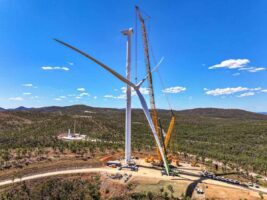Green mortgages are becoming a new way to attract the rapidly shrinking pool of mortgage customers – and some have the federal government’s financial backing.
The Clean Energy Finance Corporation (CEFC) is investing $125 million into CBA’s green home mortgage, as a way to cut emissions in the housing sector via more energy efficient houses.
The deal gives a 0.18 per cent discount for mortgages on new homes built to the Green Building Council of Australia’s (GBCA) Green Star Home standard, or existing homes renovated and retrofitted to achieve a Nationwide House Energy Rating Scheme (NatHERS) rating of seven. The CEFC investment supports half of the discounted rate over the first five years of the loan. After that, CBA will continue to offer the full discount for the remainder of the loan.
It’s the third green mortgage product the CEFC has invested in. It backed a Bank Australia home loan in 2020 to the tune of $120 million, and another by Firstmac in 2021 with a $108.5 million investment.
Green mortgages now make up about 1 per cent of the CEFC’s portfolio. It also funds consumer loans which allow homeowners to upgrade their property or buy electric vehicles, and is investing in large-scale residential developments such as senior and community housing, build-to-rent sector and specialist disability accommodation.
There are at least eight green home loan products on the market which reward new or existing homes which meet a minimum NatHERS rating of seven, or which have lifted their rating by installing tech such as real-time energy monitoring systems, solar panels and batteries, efficient hot water systems, double glazing and insulation.
Aim to cut emissions and cost of living
Housing is a critical area for the government’s net zero ambitions, as Australia’s apartment and house stock account for almost a quarter of national electricity use and some 11 per cent of emissions, according to the GBCA.
And with the Reserve Bank expected to lob its tenth rate rise in a row this week, a saving of $1350 in interest in the first year of a $750,000 mortgage, according to CEFC calculations, a sum not to be sniffed at.
“It’s great to see the CEFC, the world’s biggest green bank, make smart partnerships to incentivise energy efficient homes,” climate change and energy minister Chris Bowen said.
“Powering homes with battery-ready solar PV, as well as installing better insulation and windows, will help households cut power bills and emissions.”
The federal government is developing a National Energy Performance Strategy to improve household energy performance, as part of a broader $15.2 million investment to look at the demand side of electricity use.
CEFC CEO Ian Learmonth says discount green home loans are a powerful tool to drive down emissions and build future-proofed houses.
“This latest investment brings our total commitment to green home finance to $350 million since 2020, when the CEFC took the lead in supporting initiatives to boost Australia’s energy efficient housing,” he said in a statement.
Returns from the CEFC’s banking investments are confidential, a spokesperson from the CEFC told RenewEconomy.
RenewEconomy is seeking comment from CBA.
Green mortgages could be big business
Green mortgages is an increasingly interesting area for banks competing for now scarce home loan customers.
Data from the Australian Bureau of Statistics (ABS) shows the value of home loans in January is down 35 per cent year-on-year, and loans to first home buyers are down 57.5 per cent from a peak in 2021 and at a five year low.
Three of the big four banks offer some kind of green home loan, although only CBA and NAB offer discounts on a full mortgage. ANZ offers a mortgage top-up for sustainability renovations. Westpac offers personal loans for electric vehicles and solar panels.
Other green home loan lenders are Gateway Bank, Regional Australia Bank, Loans.com.au, and RACQ Bank.
But as with many mortgages, the devil is in the details.
Bank Australia and Firstmac only offer the discount for the first five years of the loan. Regional Australia Bank’s is only for refinancers. Loans.com.au and Firstmac only work with new-build homes. And most cap the total value of the mortgage at between $1.5 million and $3 million.
However, a borrower who can navigate the strict criteria of what banks want to see in a green home receives perks such as lower ongoing energy bills, savings in an era of rising rates, and discounts on lenders mortgage insurance for mortgages over an 80 per cent loan-value ratio.
Currently Australian lenders offer home upgrade and mortgage products for the green home market, found QBE’s 2022-2025 Housing Outlook: Green Edition report last year.
And while the market is still in its infancy, the QBE report uncovered a detail that will be interesting to all lenders concerned about borrower’s capacity for higher payments.
“Studies conducted in the USA and the Netherlands indicate that a higher building energy rating is associated with significantly lower probability of mortgage default. This suggests that energy efficient ratings complement borrowers’ credit information and that lenders using this information can make superior lending decisions than traditional credit information,” it said.










